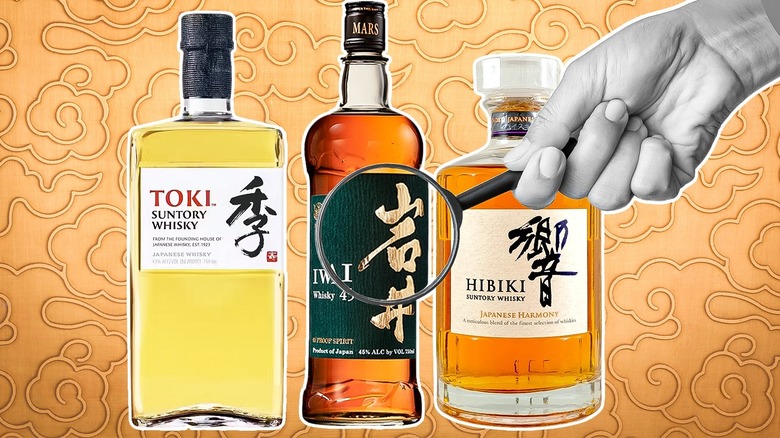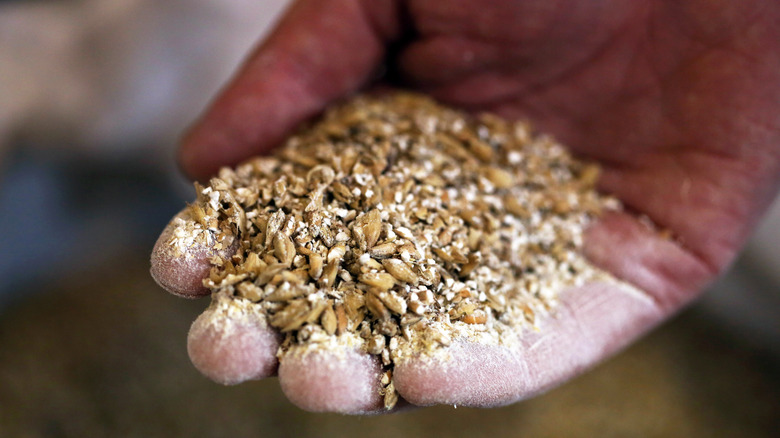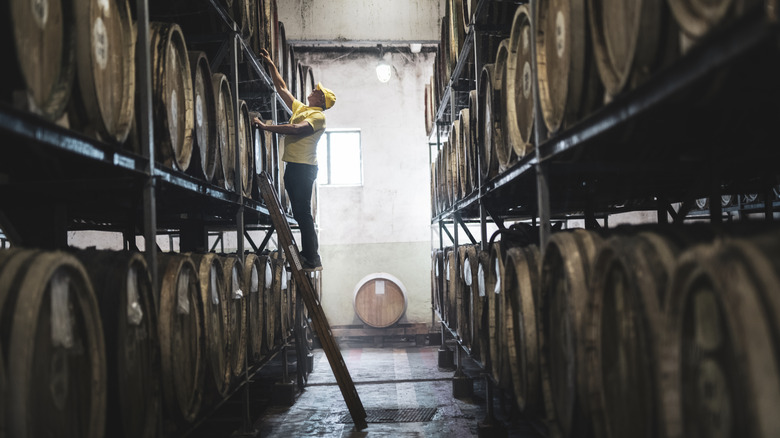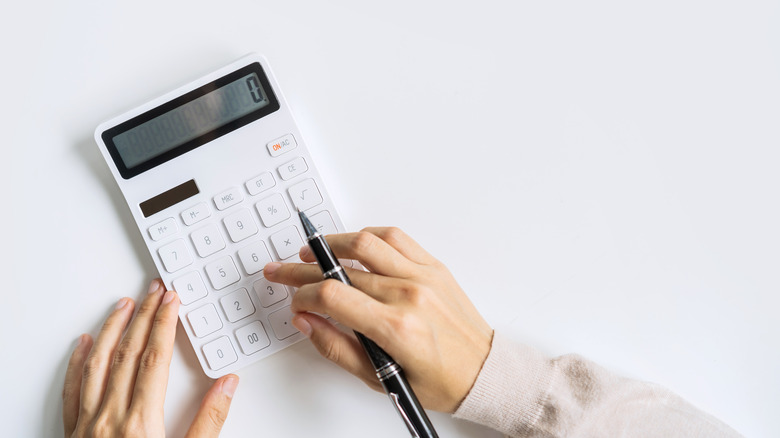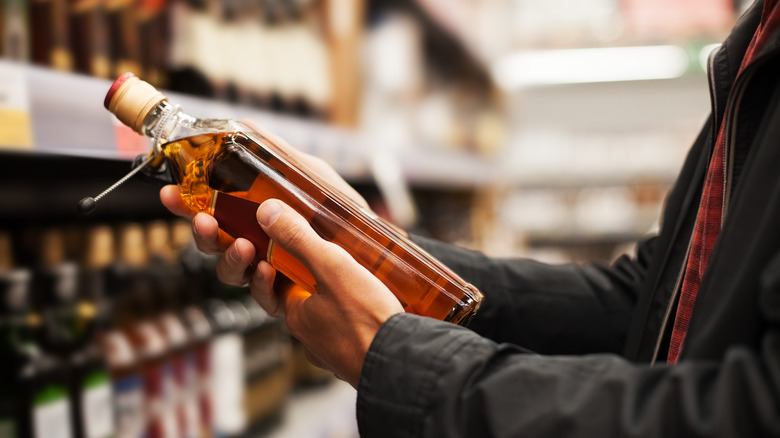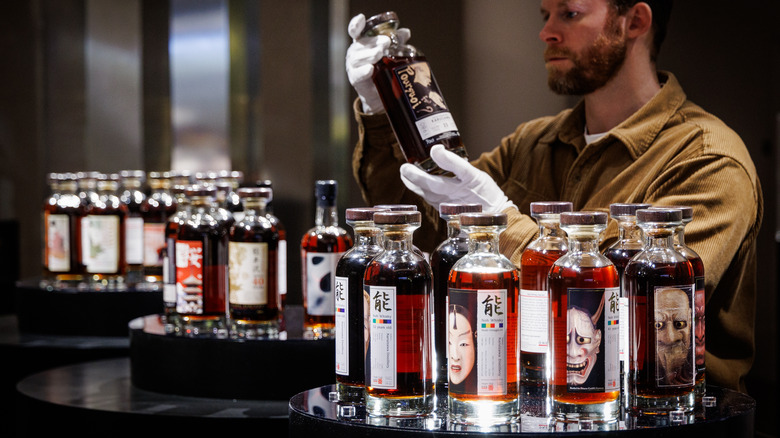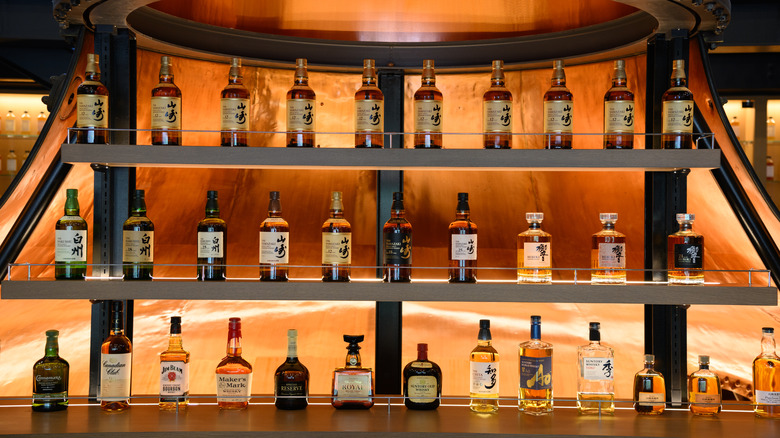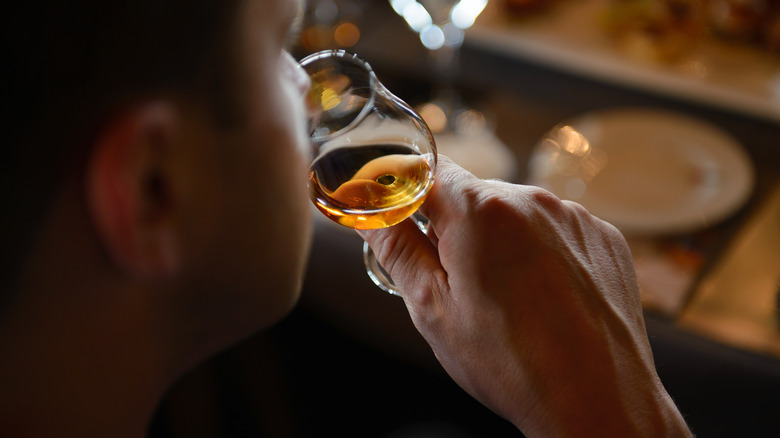11 Ways To Tell If Your Japanese Whisky Is Authentic, According To Industry Experts
While Japanese whisky (spelled without the "e" after Scottish style) has been around for a century, it has only become popular stateside in recent years. While the international market for Japanese whisky remained virtually nonexistent for a time, in 2001 Nikka's 10-year Yoichi single malt won "Best of the Best" at Whisky Magazine's awards. Later, the 2013 Yamazaki Sherry Cask won "Best Whisky in the World" by Whisky Bible in 2015. Since then, exports of Japanese whisky have risen sharply. (According to Trade Data Monitor data as reported by the United States Foreign Agricultural Service, exports are up 233 percent since 2013 — from $40.8 million in sales to $135.8 million.)
And, due to the increased demand, prices for Japanese whisky — especially for older, rarer products — likewise increased. Producers, according to the Foreign Agricultural Service, are also struggling to keep up with demand, "as quality aged whiskey is a labor-intensive product and requires long lead times." This has led to an increase in falsely advertised and counterfeit products looking to take advantage of the whisky craze. But this raises the question: What constitutes an authentic Japanese whisky?
Tasting Table spoke with Jun Tanaka, alcohol responsibility committee chair for the Japan Spirits and Liqueurs Makers Association (JSLMA), as well as James Bowker, House of Suntory global advocacy manager, to learn more about Japanese whisky's explosion in popularity and how consumers can avoid being fooled.
Check the ingredients
Fortunately, in recent years, strict regulations determined by the government-approved JSLMA have been created to clearly identify what qualifies as a Japanese whisky (as opposed to the many other varieties of the spirit). This was "aimed at curbing the spread of products misleadingly labeled as 'Japanese whisky,'" Bowker tells us. The "Standards for Labeling Japanese Whisky" might have been enacted in 2021 but wasn't set for enforcement until April 1, 2024. The regulations stipulate that raw ingredients must be limited to malted grains, other cereal grains, and water extracted in Japan. Also, malted grains must always be used and plain caramel coloring may be used.
The use of any additional or other ingredients will no longer qualify the spirit as an authentic Japanese whisky. Whiskies that fail to meet the above criteria, according to the JSLMA "Labeling Standards," will not be allowed to include the names of people that evoke Japan, the names of Japanese cities, regions, famous places, mountains, and rivers, or the Japanese flag or Japanese era name on its labeling ("unless measures are taken to clarify that the product being labeled does not meet such requirements"). In other words, the product must be an authentic Japanese whisky to have packaging that evokes Japanese names or imagery.
Major brands like Suntory, Bowker says, support these new regulations, "as they will go some way in helping to preserve the prestige and quality of the Japanese whisky category."
Learn about the production method
If you are unable to determine the ingredients of the whisky, try to learn how it was produced. The JSLMA "Labeling Standards" have specified a proper production method for a spirit to be considered a Japanese whisky. What does that entail? Among other details, saccharification (the process of extracting sugars from grain into a 'wash'), fermentation, and distillation must be carried out at a distillery in Japan. The distilled product must be poured into wooden casks and matured in Japan for at least three years afterward. Bottling must take place only in Japan, with an alcoholic strength of at least 40% at such time.
This means any product, for instance, which has an ABV below 40%, was aged for fewer than three years, or was bottled outside of Japan no longer qualifies as Japanese whisky. These factors are important: Japan's water sources and climate (which are crucial for the growing of the required ingredients, as well as in the barrel-aging process) are what give Japanese whisky its distinct flavor. As Bowker explains: "Every quality whisky is unique to the place it is made, so the terroir for each Japanese distillery is incredibly important."
Look at the spelling
Another clear indicator of a proper Japanese whisky is in how it's spelled. Whiskey ("e" included) is most common in the U.S. and Ireland, whereas the spelling sans "e" was popularized in Scotland. Why, then, does Japan follow the trend set by Scotch whisky? Well, Japan began making whiskies after Masataka Taketsuru, the eventual founder of Nikka Whisky, traveled to Scotland in 1918 to learn how they made their whisky. After apprenticing at three Scotch distilleries, he returned to Japan in 1920 and produced the country's first whisky at the Yamazaki Distillery. The naming convention stuck.
That said, the JSLMA's "Labeling Standards" indicate that an authentic Japanese whisky may use either spelling — with or without the "e." While this does muddy the water a bit, many of Japan's top whisky producers, including The House of Suntory and Nikka Whisky, maintain the Scottish style of spelling. So always be sure to check the labeling.
Going one step further, "If 'Japanese whisky' is not stated on the bottle at all, it's likely the new ["Labeling Standard"] are not met," says Bowker. "If a specific distillery is not mentioned on the label, it's also unlikely the new standards are met, as the location of the distillery will generally be utilized. Finally, when regulations are met, brands are likely to be explicit in stating their provenance and reference to Japan; if this is unclear, the product may not meet the new standards."
Do a little math
Whether you're unable to determine the validity of the whisky from the above steps, or maybe you can't find the necessary information to make a sound judgment, it might be time to do a little math. As Japanese whisky has become increasingly popular around the world, so have its imitators. Brands may be trying to take advantage of the current craze (and prices) by buying up foreign batches of whisky to label as their own or by quickly producing their own and labeling it as something better. For instance, if a bottle says the whisky has been aged 12 years, but if you look up the history of the distillery and it acquired its license or was founded more recently than that, you will know something isn't right.
The website Nomunication (which focuses on the food and drink of Japan) has a very handy Japanese whisky distiller tracker. That said, the chart — which notes both when the distillery opened and released its first single malt — dates only to 2015, as this was when a myriad of new distilleries in Japan began popping up. For a more comprehensive look at Japan's whisky distillers, the website also offers a Japan distillery map, which includes information about when they each opened. You can use these or do a quick Google search to learn more about the distillery; after that, it should be some simple subtraction to determine if the math — and whisky — checks out.
Try to determine the distiller
If, in trying to complete the aforementioned math, you are unable to even determine who the spirit's producer is, it may very well be a fake." Companies that are trying to hide the distillery are likely doing so for a reason. Perhaps they have sourced their whisky from outside of Japan and have bottled it to appear authentic. These companies may go one step further and include language like "Product of Japan," which, technically, might not be incorrect (especially if it's bottled in and distributed from the country) but is not as clear as a label that reads, "Distilled in Japan" (and even then, as mentioned earlier, there are strict regulations as to what that can entail).
If you're having trouble determining the producer, you might think it's a smaller/lesser-known distillery and they simply have not put their name on the label. As Bowker explained, this would be unlikely. These producers, perhaps more than any others, would want to be extremely clear with their labeling as they are trying to make their brand known. Any real-deal product will make it explicitly clear it is such. If the bottle doesn't confirm that, be wary.
Compare prices
Japanese whiskies on Drizly, an online ordering and delivery platform for alcohol purchases, have an average unit price that's more than double the average price of all whiskies sold on the site. It's perhaps the top reason why counterfeit Japanese whisky has become nearly as popular as the real deal. "I think any premium product that enjoys a prolonged period of successful growth is always going to be subject to fakes," Bowker says. "In that regard, Japanese whisky is no exception."
While this can make finding a deal on a product a bit of a challenge, it also should worry consumers that if they stumble upon a price that's significantly lower from one retailer than all the others, it should set off an alarm. Likely, if the price sounds too good to be true — especially when looking to purchase a rare or vintage product — chances are it probably is. In this instance, it may be that a counterfeiter is looking to sell a product disguised as an expensive whisky at a slight discount to the proper price because it is still a tremendous markup for the cost to produce it.
Tanaka recommends being very cautious, adding that whisky drinkers should only purchase products from trusted sources. This will very likely help you avoid purchasing an inauthentic Japanese whisky.
Inspect the bottle
If you're buying the product in person (rather than online), get your hands on the bottle and give it a thorough inspection. Examine everything from its appearance to its weight. Does the label, seal, and fill level match a verified product (whether that's one you currently own or found on the distiller's website)? Additionally, does the bottle appear to have the proper weight? To paraphrase Martin Ferrero's character in "Jurassic Park," if it's heavy, then it's expensive. If a bottle feels a bit too light, that could be indicative of a cheaply made bottle and a possible fake.
If you're looking to purchase an aged product, there are additional signals to look for. Older whiskies often have sediment at the bottom, especially if they were matured in sherry casks. The absence of sediment could indicate the bottle was refilled with a newer and cheaper whisky. You can also give the bottle a little shake to see how many bubbles form at the top. Stronger liquors — which Japanese whisky typically is — will have bubbles that last for a bit (up to 20 or 30 seconds), while weaker spirits will have bubbles that disappear nearly instantly.
See if it's sold in Japan
You should consider whether a product is an authentic Japanese whisky or something designed to fool the foreign market, one indicator could be if it's actually sold in Japan. This requires a bit of creative problem-solving because, if you're currently not located in Japan, your internet browser will default to retailers and websites in your country. So, in trying to determine if a whisky is, indeed, available in Japan, you might not actually be able to find out. And keep in mind, this isn't a blanket rule because popular varieties, such as Toki Suntory Whisky, are made for foreign consumption and aren't available for sale in Japan; however, it's a good place to start.
Try, then, searching for the brand name/product in Japanese (Google Translate will be your friend here) or searching on the Japanese version of websites (like Amazon JP). If you're able to find the product available in the Japanese market, you should feel confident that it's a genuine product. This is especially handy when looking to purchase a whisky from a boutique distillery, one that might not yet have international acclaim — but you're the type of person who has to be the first to try something new. Protect your investment by first doing a little research.
Become familiar with the major players
While it's possible that any whisky can be counterfeit, by sticking to the "major players" that are available at trusted retailers — whether online or at a store location — you will likely avoid issues with authenticity. This is a good tip if you're newer to the world of Japanese whisky and you don't quite know your way around yet.
It might also be a good idea to learn a bit about the major food and beverage conglomerates that might own several brands, including The House of Suntory. Bowers tells us that Suntory is one of the only Japanese producers with internationally available whiskies that are 100% compliant and therefore authentically Japanese whiskies. Not all major producers will be of the highest quality (this is true for any style of spirit), but this will give you a good idea of whether a parent company is more about producing large quantities of affordable spirits or a smaller amount of high-quality products.
Some of the most common, tried-and-true Japanese whisky brands include The House of Suntory whisky portfolio (encompassing Hibiki, Yamazaki, Hakushu, Toki, Ao, Kakubin, and more) and Nikka Whisky. You can also consider this list of the 12 best Japanese whiskies to learn a bit more about the products and which you might find the most enjoyable. Even better is that none of them will break the bank.
Buy directly from the source
Perhaps the best way to ensure you are not purchasing a fake product is to go directly to the source: the distillery. By cutting out the middlemen, you can guarantee that the product is, at the very least, produced by the distiller it claims to be produced by. That said, it's still important to do your research on the distillery; just because it's located in Japan does not mean the product is an authentic Japanese whisky as defined by the Japan Spirits and Liqueurs Makers Association.
A producer and distillery that's doing things the proper way, especially in light of the new "Labeling Standards," will want to make it clear that it's creating an authentic Japanese whisky. This information should surely be available on its website, but if it's not, and you're looking to purchase directly from the source anyway, simply ask them about their ingredients and processes, and confirm for yourself. Remember: You want to ask about the ingredients, the production method, the aging process, and where the bottling takes place.
Go by the taste
Now, all of the above tips should help if you're looking to purchase a bottle — but they might not help if you're at a bar or restaurant and are simply looking to buy by the glass. Granted, there are myriad Japanese whisky distillers, all making different products, so the flavor profile may vary from one whisky to the next, but there are some key elements that make Japanese whiskies stand out. According to the Tanaka, with Japanese whisky, you can expect "smoothness, complexity, aromas of fruit such as citrus, fruit trees, and tropical fruits," as well as "delicate floral notes, honey, spice, [with a] balanced and elegant finish." In addition to the region that the whisky is produced in, the "variety of barrel types, including ex-bourbon, sherry, and Mizunara casks ... provide unique flavors and aromas."
Japan's hot, humid summers and cold winters also speed up the maturation process of the whisky, meaning a younger product can develop a bolder flavor than, say, a Scotch whisky at that same time.
To enjoy the maximum flavor of the whisky, try this expert-approved approach to tasting. Whether served on the rocks or neat, first consider its aromas (our sense of smell is responsible for 80 percent of what we taste), then take a small sip, allowing you to taste some of the flavors without overwhelming your tastebuds. After that sip, take a pause, and then have a second, more savoring sip.
